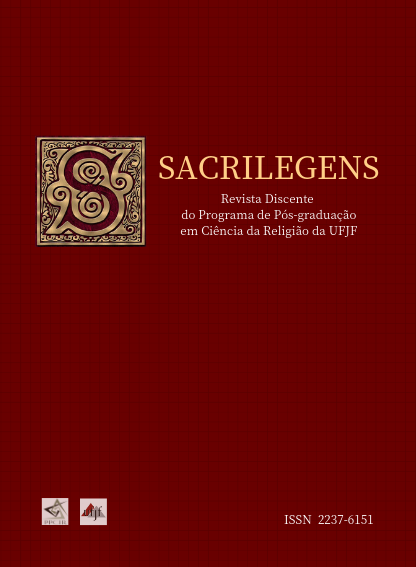Religiosidades, deusas e a polissemia do feminino na Índia
DOI:
https://doi.org/10.34019/2237-6151.2017.v14.26970Palavras-chave:
feminino, imaginário simbólico religioso, deusasResumo
O presente artigo tem o intuito de apresentar e contextualizar através dos símbolos e mitos constituintes da experiência religiosa do subcontinente indiano, a pluralidade de representações e funções do feminino. O imaginário religioso hindu aponta para um campo amplo e fértil de imanência do princípio feminino ontológico, que se traduz numa composição simbólica múltipla. Esta riqueza da simbologia do feminino religioso se expressa de maneira heterogênea nas mais diversas representações das deusas, tradicionalmente divididas em dois principais eixos, a saber: as deusas benevolentes que geralmente aparecem como consortes das deidades masculinas e as deusas ferozes, independentes e geralmente associadas ao princípio absoluto transcendente-imanente, brahman.
Downloads
Referências
indiana Devi Gita – o Cântico da Deusa.In:Congresso da Associação Nacional de Pós-
Graduação em Teologia e Ciência da Religião (4.:2013: Recife,PE) [Anais do] IV
Congresso da Associação Nacional de Pós-Graduação em Teologia e Ciência da
Religião: “O futuro das Religiões no Brasil”/[organizadores Gilbraz S. Aragão,
Newton Darvin A. Cabral] – São Paulo: ANPTECRE, 2013. 2320 p.
COBURN, Thomas B. The Great Goddess. In: Devī: Goddesses of India.
MotilalBanarsidass: Delhi, 1998.
CROATTO, José Severino. As Linguagens da Experiência Religiosa: uma
introdução à fenomenologiadareligião.São Paulo: Paulinas, 2001.
DOLD, Patrícia. KalitheTerrificandherTests. In: Encounteringkali: In theMargins,
atthe Center, in the West. UniversityofCalifornia Press: Delhi, 2005.
Encyclopedia of Hinduism. New York: Infobase Publishing, 2007.
FLOOD, Gavin.An Introduction to Hinduism. Cambridge University Press:
Cambridge,UK, 1996.
HAWLEY, J.S. Prologue: The Goddess of India. In: Devī: Goddesses of India.
MotilalBanarsidass: Delhi, 1998.
JUNG, Carl. O Homem e seus símbolos. Nova Fronteira: Rio de Janeiro, 2008.
KINSLEY, David R. Kālī, Blood and Death out of Place. In: Devī: Goddesses of India.
MotilalBanarsidass: Delhi, 1998.
LAMA, Stephanie Tawa. The Hindu GoddessesandWomen’sPoliticalRepresentation in
South Asia: SymbolicResourceorFeminineMystique? RevueInternationale de
Sociologie, 11, 1, 2001: 5-20.
MATCHETT, Freda.ThePuranas. In: Blackwell Companion to Hinduism.Blackwell
Publishing Ltd: Oxford, Uk, 2003.
MCDERMOTT, Rachel Fell. The Western Kālī. In: Devī: Goddesses of India.
MotilalBanarsidass: Delhi, 1998.
MESQUITA, Hugo. O FemininonaPsicologiaJunguiana. 2013. 29f. Monografia
(GraduaçãoemPsicologia).Universidade Federal Fluminense, Rio das Ostras - RJ, 2013.
NIKHILĀNANDA, Swāmī. The Gospel of Sri Ramakrishna. New York: Ramakrishna-
VivekanandaCentre, 1942.
PATEL, Kartikeya C. Women, earth, and the Goddess: a Śākta-Hindu interpretation of
embodied religion. In: Brill’s Indological Library. Brill Leiden: Boston, 2005.
PATTANAIK, Devdutt. The Goddess in India: the five faces of the eternal feminine.
Inner Traditions International: Vermont, 2000.
WILKINS, W. J. Hindu Mythology, Vedic and Puranic.Rupa e Co: New Delhi, 1982.
ZIMMER,Heinrich. Filosofias da Índia. São Paulo: Palas Athena, 1986.
Downloads
Publicado
Como Citar
Edição
Seção
Licença
 A Revista Sacrilegens é um periódico de acesso aberto, licenciada sob a licença Creative Commons Attribution 4.0 International
A Revista Sacrilegens é um periódico de acesso aberto, licenciada sob a licença Creative Commons Attribution 4.0 International










